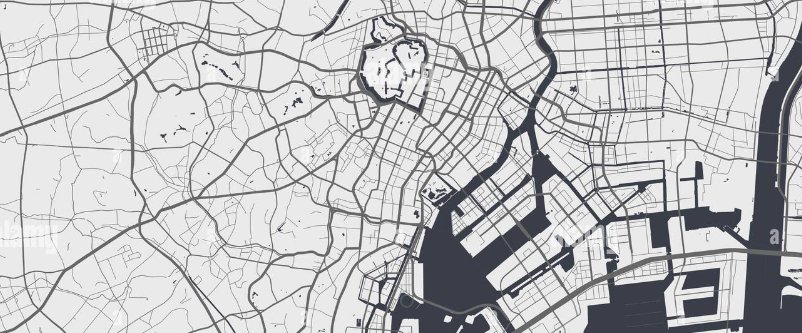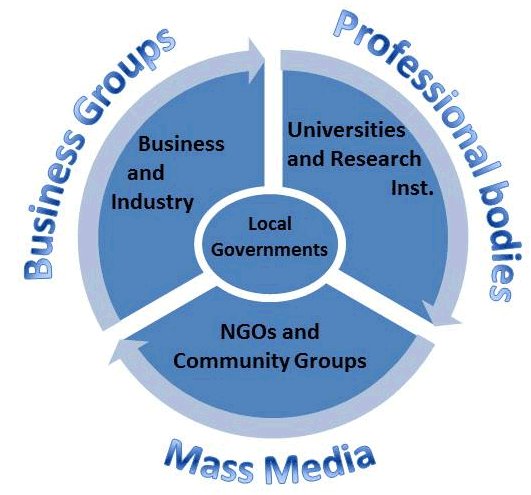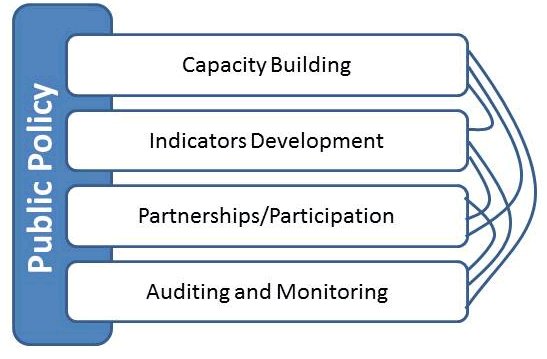Need of the Day

| Hari Srinivas | |
| Concept Note Series E-045. April 2015. |
Abstract:
As the world's urban population burgeons, the ensuing opportunities are matched only by the formidable challenges posed. Amidst this unprecedented urbanization, the imperative for effective governance becomes ever more pronounced. Good urban governance emerges as the linchpin in navigating the complexities of burgeoning cities, offering not merely a framework but a paradigm shift towards inclusivity, transparency, and collaboration.
At its core lies a commitment to fostering environments where citizens are not mere recipients of decisions but active participants in shaping the urban landscape. Through equitable decision-making processes, transparent governance mechanisms, and collaborative initiatives, good urban governance aspires to forge cities that are not only resilient in the face of adversities but also vibrant hubs of shared prosperity. This document delves into the essence of good urban governance, emphasizing its pivotal role in steering urban development towards sustainability, resilience, and equitable growth.
Keywords:
Urbanization, Good urban governance, Citizen participation, Equitable decision-making, Transparent governance mechanisms, Collaborative initiatives, Resilient cities, Shared prosperity.
E
very second, the world's urban population swells by two souls. By 2050, three in five people will call a city home. This unprecedented urbanization presents tremendous opportunities, but also colossal challenges. Managing transportation, ensuring sustainability, and fostering social cohesion within these burgeoning metropolises demands nothing less than a revolution in how we govern them. Enter good urban governance, a paradigm shift that puts citizens at the helm, paving the way for vibrant, equitable, and resilient cities.Can a city truly thrive if its heart beats only for the privileged few? If its streets echo with frustration instead of collaboration? If its decisions are shrouded in secrecy instead of bathed in transparency? The answer, resounding and clear, is no. But there's a potent antidote to this urban malaise ? good urban governance. It's a philosophy, a blueprint, and a rallying cry for a future where all voices are heard, where equity reigns supreme, and where cities become catalysts for shared prosperity.
In recent dialogues on urban management, 'good urban governance' has received currency along with other key tools such as decentralization and local autonomy. Various local, national, regional and international organizations have undertaken considerable efforts to incorporate the tenets of good urban governance in realizing sustainability in cities, and meet the challenges of rapid urbanization and local environmental degradation.
Defining Good Governance
Along with the development of the concept of good governance, its definitions, attributes and indicators have also envolved. Good urban governance has been defined as an inclusive process in achieving a quality of life sought by the residents of cities, especially the disadvantaged, marginalized and poor.
The operational keywords of governance - and consequently its goals - have been applicability, equity, acceptability, and ownership of governance processes at the local level. This calls for the development of a framework or matrix within which cities and urban stakeholders can assess and prioritize governance indicators to measure urban governance performance.
Governance is about accessibility, accountability, transparency and efficiency ... |
The many facets of good urban governance and its relevance to all aspects of city management and the delivery of urban goods and services calls for in-depth efforts to educate and raise awareness on issues related to governance at all levels of a city or urban area, from a community to a region. These efforts need to develop ownership of governance at the local level to ensure acceptability and effective implementation.
To build on existing and ongoing efforts to incorporate the tenets of good urban governance in city management (policies, programmes, projects, and plans) requires action by all urban stakeholders and the development of a set of tools and resources, and for broad capacity building in good urban governance.
Information and Knowledge Resources
There is a need to facilitate the internalization of the concept of good urban governance, in order to build understanding and capacity at the local level, by developing a range of information and knowledge resources to assist us in these processes. Guidelines, checklists and benchmarks need to be developed that will guide in the application of good urban governance.
Training sessions, short-term courses and on-the-job education need to be organized in order to ensure professional development of urban officials and of the general public they interact with and serve. Dialogues also need to be initiated amongst various local stakeholders on good urban governance
To achieve this, local governments will have to partner with other local authorities, training and research institutions, NGOs and community groups, private sector entities, national agencies and ministries, and UN agencies. Local and regional partners will have to be identified for this purpose, and develop appropriate governance resources and tools.
Good Governance Indicators
Focusing on broad involvement and inclusiveness in good urban governance, there is a need to educate and build awareness on the tenets of good governance, by developing a 'governance inventory' that will document and package information on good governance practices. This can be operationalized by developing a framework within which common indicators can be used to document best practices on good governance.

Figure 1: Interplay of Governance Stakeholders
Wide acceptance and ownership of the concepts and tents of governance need to be garnered, and the effective sharing and dissemination information on good governance practices. To achieve this, local governments will have to partner with a range of local and international organizations, including local authorities citizens groups, NGOs, and UN agencies - and formulate a common framework for good governance, along with a governance inventory.
Participation and Partnership
Focussing on local action, multi-stakeholder coalitions will have to be built that monitor and evaluate actions towards good governance, and will advise and guide implementation. To do this, broad participation and partnership among all local stakeholders in the development of good urban governance will have to be ensured at the local level.
Efforts towards institutional and administrative reform will have to be initiated, and is widely accepted and implemented. Action for networking and resource sharing will have to be taken so that the intended impacts of good governance is achieved.

Figure 2: Operationalizing Good Governance
Auditing and Evaluation
Finally, mechanisms for third-party auditing and evaluation of programmes and actions will have to be put into place. To achieve this, local governments will have to partner with NGOs and citizens groups, with other cities in the country and region, and with private sector entities. A set of monitoring and evaluation tools will have to be developed to guide implementation, and to identify appropriate partners and resources who can assist in these processes.
A Way Forward
In an era where cities have been growing with unprecedented speed, the imperative for effective urban governance has never been clearer. As urban landscapes swell and diversify, the challenges they face demand innovative solutions rooted in inclusivity, transparency, and collaboration. Good urban governance is critical to meet these challenges, where citizens are empowered, resources are allocated equitably, and sustainability is prioritized.
When addressing the complexities of urbanization, education and awareness emerge as vital tools in fostering a culture of governance that particularly critical at the grassroots level. By embracing technology for transparency, prioritizing green infrastructure, fostering collaboration across sectors, and championing inclusivity, cities can pave the way for a future where every voice is heard and every community thrives.
Good urban governance requires partnerships that transcend boundaries - participation that amplifies diverse voices, and a commitment to continual evaluation and adaptation. Collaboration among stakeholders-ranging from local governments to international organizations-will be essential in realizing the full potential of good urban governance. Multi-stakeholder coalitions need to be cultivated to monitor progress, evaluate actions, and provide guidance for implementation. Institutional and administrative reforms, driven by broad participation and partnership, will lay the groundwork for such meaningful change.
This call for good urban governance will be important as a catalyst for cities to develop and thrive, for the benefit of all. By embracing inclusivity, transparency, and collaboration, cities can harness the full potential of their diversity and dynamism, becoming models of sustainability, resilience, and shared prosperity.
|
|

